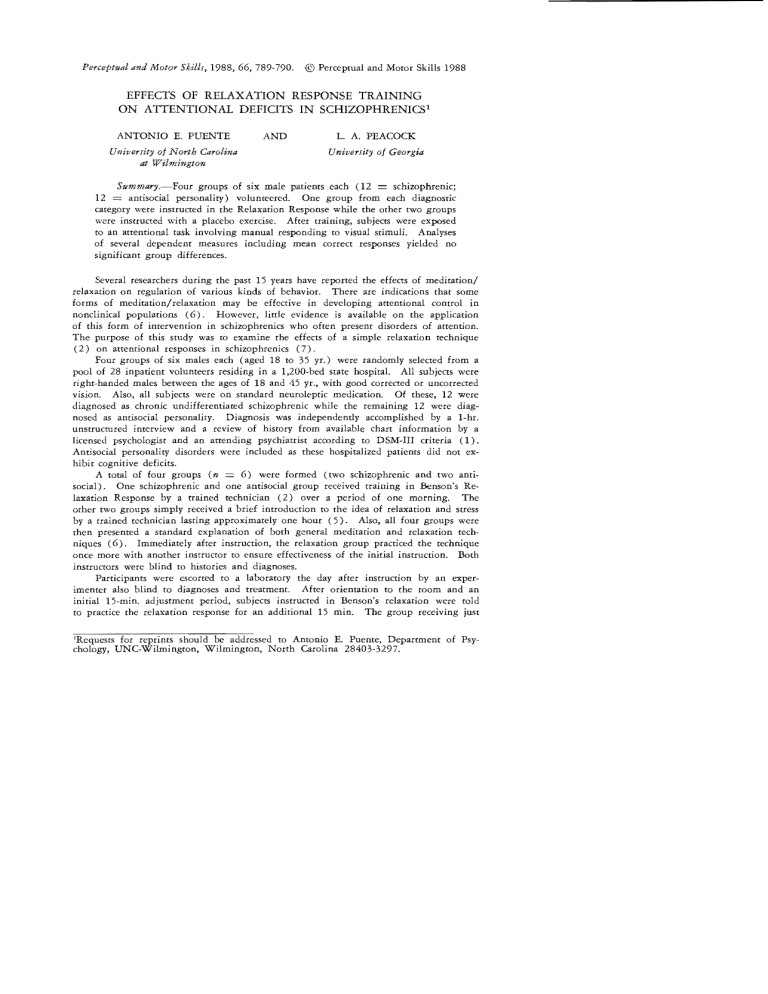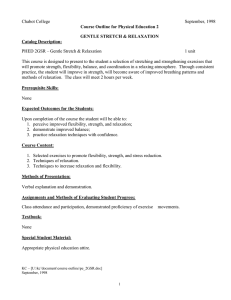Effects of relaxation response training on attentional deficits in

Perceptual and Motor Skills, 1988, 66, 789-790.
©
Perceptual and Motor Skills 1988
EFFECTS OF RELAXATION RESPONSE TRAINING
ON ATTENTIONAL DEFICITS IN SCHIZOPHRENICS
1
ANTONIO E. PUENTE
University of North Carolina at Wilmington
AND L. A. PEACOCK
University of Georgia
12
Summary.-Four groups of six male patients each (12
= antisocial personality) volunteered.
= schizophrenic;
One group from each diagnostic category were instructed in the Relaxation Response while the other two groups were instructed with a placebo exercise. After training, subjects were exposed to an attentional task involving manual responding to visual stimuli. Analyses of several dependent measures including mean correct responses yielded no significant group differences.
Several researchers during the past 15 years have reported the effects of meditation/ relaxation on regulation of various kinds of behavior. There are indications that some forms of meditation/ relaxation may be effective in developing attentional control in nonclinical populations (6). However, little evidence is available on the application of this form of intervention in schizophrenics who often present disorders of attention.
The purpose of this study was to examine the effects of a simple relaxation technique
(2) on attentional responses in schizophrenics (7).
Four groups of six males each (aged 18 to 35 yr.) were randomly selected from a pool of 28 inpatient volunteers residing in a 1,200-bed state hospital. All subjects were right-handed males between the ages of 18 and 45 yr., with good corrected or uncorrected
VlSlOn. Also, all subjects were on standard neuroleptic medication. Of these, 12 were diagnosed as chronic undifferentiated schizophrenic while the remaining 12 were diag nosed as antisocial personality. Diagnosis was independently accomplished by a I-hr. unstructured interview and a review of history from available chart information by a licensed psychologist and an attending psychiatrist according to DSM-III criteria (1).
Antisocial personality disorders were included as these hospitalized patients did not ex hibit cognitive deficits.
A total of four groups (n
=
6) were formed (two schizophrenic and two anti social). One schizophrenic and one antisocial group received training in Benson's Re laxation Response by a trained technician (2) over a period of one morning. The other two groups simply received a brief introduction to the idea of relaxation and stress by a trained technician lasting approximately one hour (5). Also, all four groups were then presented a standard explanation of both general meditation and relaxation tech niques (6). Immediately after instruction, the relaxation group practiced the technique once more with another instructor to ensure effectiveness of the initial instruction. Doth instructors were blind to histories and diagnoses.
Participants were escorted to a laboratory the day after instruction by an exper imenter also blind to diagnoses and treatment. After orientation to the room and an initial I5-min. adjustment period, subjects instructed in Denson's relaxation were told to practice the relaxation response for an additional 15 min. The group receiving just
'Requests for reprints should be addressed to Antonio E. Puente, Department of Psy chology, UNe-Wilmington, Wilmington, North Carolina 28403-3297.
790
A. E. PUENTE & 1. A. PEACOCK a rationale for relaxation was instructed to relax as best as they could. After 15 min. of practicing some form of relaxation, subjects were then presented the experimental task. Three randomly timed (variable interval of 1 to 3 sec.) red flashing lights lo cated approximately rwo feet in front of the subject were presented for 5 min. (a total of 20 continuous trials of 15 sec. each with a potential for 900 lights during the entire sitting). Each participant was to respond to the lights by pressing one of three cor responding red buttons on a metal box which was placed on the lap. Correct respond ing was scored when a subject pressed the button which matched the flashing light be fore the next flashing light. An initial practice period, which allowed the participants to become familiar with the apparatus and procedure, preceded actual assessment. The attention task was fashioned as suggested by Cromwell (3) using the protocol developed by ]erison (4).
Analysis of variance (group X instruction X trials) of total correct responses per set indicated that there was no significant difference in responses of the four groups to the attention task, either berween the rwo disorders, berween the types of instruction, or in the interaction of disorders by instructions. Table 1 provides the mean and standard deviation for the correct responses for each group collapsed across trials. Practice of
TABLE 1
MEAN CORRECT RESPONSES TO FLASHING LIGHTS FOR
Two ExPERIMENTAL AND Two CONTROL GROUPS (ns
=
6)
Clinical Groups N
Relaxation
M SD
Instructions
M
Placebo
SD
Schizophrenic
Antisocial
6
6
12.6
10.6
2.1
1.9
17.9
18.6
2.4
1.6 a simple relaxation procedure does not improve eXlstlOg attention in either schizophrenic or antisocial personality inpatients as measured by the task used in this study. How ever, several issues should be considered in interpreting these findings. First, although random assignment to treatment groups was used, no pretreatment baseline measure was made which masked potential treatment effects. Second, more trials (of flashing lights) may have eventually yielded change in the attention of the treatment groups. Groups should be larger.
REFERENCES
1. AMERICAN PSYCHIATRIC ASSOCIATION. (1980) Diagnostic and statistical manual.
(3rd ed.) Washington, DC: American Psychiatric Assn.
2. BENSON, H. (1975) The relaxation response. West Caldwell, N]: Morrow.
3. CROMWELL, R. 1. (1975) Assessment of schizophrenia. Annual Review of Psy chology, 26, 593·619.
4. ]ERISON, H. ]. (1956) Effect of combination of noise and fatigue on a complex counting task. Wright-Patterson Air Force Base, OH, Wright Air Development
Center, US Air Force.
5. PUENTE, A. E., & BElMAN, L (1980) The effects of behavior therapy, self-relaxa tion, and Transcendental Meditation on cardiovascular stress response. Journal of Clinical Psychology, 36, 291-295.
6. SHAPIRO, D. H. (1980) Meditation. Hawthorne, NY: Aldine.
7. WYNEE,1. c.,
CROMWELL, R. 1., & MATTHYSEE, S. (1978) The nature of schizo
phrenia: new approaches to research and treatment. New York: Wiley.
Accepted April 28, 1988.



